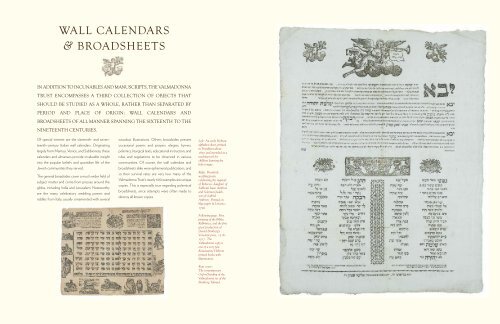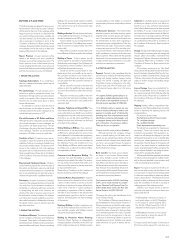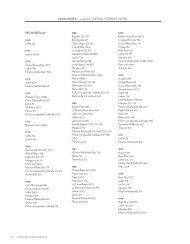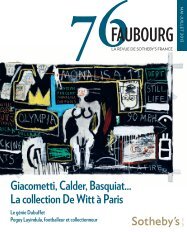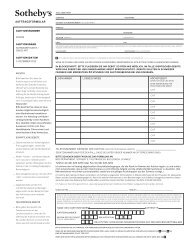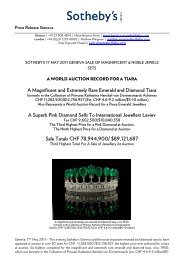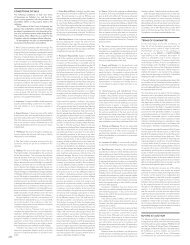Valmadonna Trust Library Brochure - Sotheby's
Valmadonna Trust Library Brochure - Sotheby's
Valmadonna Trust Library Brochure - Sotheby's
Create successful ePaper yourself
Turn your PDF publications into a flip-book with our unique Google optimized e-Paper software.
The<br />
“GOLDEN AGE” of<br />
HEBREW PRINTING<br />
THE CRADLE OF HEBREW PRINTING, ITALY REMAINED THE HOME<br />
OF THE MOST PROLIFIC, INNOVATIVE, AND SCHOLARLY HEBREW<br />
PRINTERS THROUGHOUT MOST OF THE SIXTEENTH CENTURY. BUT<br />
HEBREW PRESSES SPREAD EXPONENTIALLY AROUND THE GLOBE AT<br />
THE SAME PERIOD—TO AMSTERDAM, ANTWERP, AND AUGSBURG;<br />
to Berlin, Breslau, and Belgrade; to Cologne,<br />
Cracow, and Constantinople; and even to Africa,<br />
where the Portuguese printer Samuel ben Isaac Ne-<br />
divot established a press at Fez, Morocco. As a result,<br />
the output of Hebrew presses increased nearly<br />
twenty-fold: some 2,700 Hebrew imprints appeared<br />
during the sixteenth century, as opposed to about<br />
140 fifteenth-century editions. And for the first time,<br />
Hebrew works were being printed by (and occa-<br />
sionally for the use of) non-Jews.<br />
Textually and typographically, the Hebrew book<br />
made monumental advances during the sixteenth<br />
century. The <strong>Valmadonna</strong> <strong>Trust</strong> library houses more<br />
than two-thirds of all recorded Hebrew printing from<br />
1501 through 1600, attaining an astonishing comprehensiveness<br />
that rivals its own holding of incunables—and<br />
which, like that collection of earliest<br />
printing, could likely never be assembled again. But<br />
although the field for collecting sixteenth-century<br />
imprints was wider than for incunabula, Jack Lunzer<br />
applied the same exacting criteria of selection—<br />
profound importance and the finest obtainable condition—and<br />
this section of the library contains many<br />
volumes whose price is far above rubies.<br />
The only complete copy<br />
on blue paper of the<br />
Mishneh Torah of<br />
Maimonides, Venice,<br />
1574–1575.<br />
significant numbers of others are either unique<br />
survivals or rare luxury examples printed on vellum<br />
or on colored (especially blue) paper. Indeed,<br />
<strong>Valmadonna</strong>’s collection of approximately 100<br />
sixteenth-century imprints on blue paper eclipses the<br />
holdings of any other library, private or institutional.<br />
Splendid volumes printed on green, yellow, and red<br />
paper (and even on silk) are also scattered along the<br />
<strong>Valmadonna</strong> shelves.<br />
Particularly noteworthy are the collections of books<br />
issued by the itinerant printer Gershom Soncino,<br />
who at Fano revived the Hebrew press after a stillunexplained<br />
hiatus from 1497 to 1503. Soncino<br />
established presses in numerous small communities<br />
of Italy (Fano, Pesaro, Ortona, Rimini, and Cesena),<br />
eventually removing to Salonika and Constantinople.<br />
He produced not just Hebrew books, but also<br />
humanist texts in Latin, of which the library also has<br />
a remarkable range.<br />
ITALY<br />
THE VALMADONNA TRUST INCLUDES VIRTUALLY COMPLETE<br />
HOLDINGS OF THE WORK OF THE HEBREW PRINTERS OF MANTUA,<br />
VENICE, FERRARA, CREMONA, PISA, VERONA, LIVORNO, AND TRI-<br />
ESTE. SUBJECT TO CONFISCATION AND CENSORSHIP, MANY OF<br />
THESE EARLY BOOKS ARE RECORDED IN ONLY A FEW COPIES;<br />
Not only is every Italian town with a Hebrew press<br />
represented in the <strong>Valmadonna</strong> <strong>Trust</strong> library, but<br />
virtually all are distinguished by at least one tremendous<br />
rarity. For instance, Genoa can claim one of the<br />
few vellum copies of Porro’s celebrated 1516 edition<br />
of the Psalms in five languages, the most ambitious<br />
linguistic work published to that time and the first<br />
polyglot text ever printed. Bologna can boast a<br />
vellum copy, with gilt-lettered headings, of the<br />
Roman rite Siddur printed by Talmi in 1537 for the<br />
famous Bolognese guild of silk-weavers. The<br />
imprints from Mantua include a blue-paper copy of<br />
Samuel Zarza’s commentary of the Pentateuch,<br />
Mekor Hayim, printed in 1559. And just as Venice<br />
was the largest center of Hebrew printing in Italy, the<br />
<strong>Valmadonna</strong> collection is also preeminent in Venetian<br />
imprints, particularly the works produced by<br />
Daniel Bomberg, Marco Antonio Giustiniani, and<br />
the Bragadin family.


